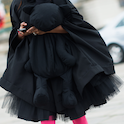Random Rhetorical Hypebeast Fashion Thoughts
Re: ramdom fashion thoughts
If you ever visit London, rose, you absolutely must go to Dover Street Market.
- 0
-

Syeknom - Posts: 2109
- Joined: Thu Jul 11, 2013 4:48 pm
- Location: Amsterdam
- Reputation: 7986
Re: ramdom fashion thoughts
I always do whenever I'm in London. One could probably say DSM is my Mecca.
- 0
-

Rosenrot - Posts: 146
- Joined: Thu Jul 25, 2013 9:14 pm
- Reputation: 2073
Re: ramdom fashion thoughts
syek when you come to england you should check out this one brand "She Welly" or something.
Think you'd like their stuff.
Think you'd like their stuff.
- 2

-

bels - Yung Winona
- Posts: 5087
- Joined: Thu Jul 11, 2013 2:43 pm
- Reputation: 18872
Re: ramdom fashion thoughts
rose what do you do that you're so balling out of reasonable control parameters
- 0
-

teck - Posts: 537
- Joined: Thu Aug 01, 2013 10:17 am
- Reputation: 1812
Re: ramdom fashion thoughts
Don't know if there's a better place to post things people should buy but cameron- assuming from the cyberpunk thread that you're down with Final Home, you should totally buy this.
http://www.ebay.com/itm/Final-Home-Coat ... 1c373067d0

http://www.ebay.com/itm/Final-Home-Coat ... 1c373067d0

- 0
-

UnwashedMolasses - Posts: 551
- Joined: Fri Sep 27, 2013 9:42 pm
- Reputation: 2222
Re: ramdom fashion thoughts
We've used opportunity costs for that before, but I don't think it matters
That's an really striking coat
That's an really striking coat
- 0
-

Syeknom - Posts: 2109
- Joined: Thu Jul 11, 2013 4:48 pm
- Location: Amsterdam
- Reputation: 7986
Re: ramdom fashion thoughts
So is that just the catch-all "You should buy thread", not necessarily just Rakuten?
- 0
-

UnwashedMolasses - Posts: 551
- Joined: Fri Sep 27, 2013 9:42 pm
- Reputation: 2222
Re: ramdom fashion thoughts
rosenrot is it true that you were abandoned by your biological parents in a basket outside DSM and you were raised by Rei Kawakubo
- 6
-

germinal - Garminlad
- Posts: 1282
- Joined: Thu Jul 11, 2013 12:18 pm
- Reputation: 5243
Re: ramdom fashion thoughts
Yes. My biological parents were a certain Rick and Michele. Managed to hunt them down though.
- 6
-

Rosenrot - Posts: 146
- Joined: Thu Jul 25, 2013 9:14 pm
- Reputation: 2073
Re: ramdom fashion thoughts
LET ME SEE U 1 2 STEP o wait thats miss ciara
FML, I'm running out of space at my place to store clothes from my freddy momma's house. But a good amount of my stuff is FW suitable already lol
FML, I'm running out of space at my place to store clothes from my freddy momma's house. But a good amount of my stuff is FW suitable already lol
- 0
-

freddy - Posts: 934
- Joined: Sun Sep 15, 2013 11:35 pm
- Reputation: 1710
Re: ramdom fashion thoughts
Freddy I like you but I don't think you lol as much as you say you lol.
- 7

-

bels - Yung Winona
- Posts: 5087
- Joined: Thu Jul 11, 2013 2:43 pm
- Reputation: 18872
Re: ramdom fashion thoughts
Holy ccraop bmy legsg ffeel so friggin cool right now
It kiinda sycks cause I bought some stuff but then I decided "Oh yeah I'd like to gain some muscle let's bulk for the winter" and now some of the shit that used to fit me great hardly firts.
My wardrobe is minimal but I've never approaced it with the idea of "let's be minimal" it was more like "I'd like to fit everything I regulary wear on my suitcase when I'm on the placne" cauyse I was flyingh a lot nd it just sort of happened
So now I've got only a few tees and most of myt tops are wight because they go wither everyinthing abd my bottoms are fun because whatevs you know and I got some cool shoes loke these shoes rule right and I got some blue Sauconies but really I'd have loved maroon pnes but they don't sell those so I got blue ones and they;re actualluy cooler than I expected.
I just want a wardrobe that's to the point where evein on days where I say "oh yeah this is my lazy day no effort fgoinhg in tofay" I'm still wearing crazy shit because even the bummiest stuff in my wardobe is crazy. And UI'm ghetting there slowly but obvy it tkes a while becauyde these materials are eexpendsive ya know so I have to accumulate graduallly as I'm stilll in college not working full time and such.
Sorry guyz I din;t mean to shiptpost I just need tsopmething t do until I drink enough water to not have a hangover ya dig? I'm sure y'all fig, your'e good people.
It kiinda sycks cause I bought some stuff but then I decided "Oh yeah I'd like to gain some muscle let's bulk for the winter" and now some of the shit that used to fit me great hardly firts.
My wardrobe is minimal but I've never approaced it with the idea of "let's be minimal" it was more like "I'd like to fit everything I regulary wear on my suitcase when I'm on the placne" cauyse I was flyingh a lot nd it just sort of happened
So now I've got only a few tees and most of myt tops are wight because they go wither everyinthing abd my bottoms are fun because whatevs you know and I got some cool shoes loke these shoes rule right and I got some blue Sauconies but really I'd have loved maroon pnes but they don't sell those so I got blue ones and they;re actualluy cooler than I expected.
I just want a wardrobe that's to the point where evein on days where I say "oh yeah this is my lazy day no effort fgoinhg in tofay" I'm still wearing crazy shit because even the bummiest stuff in my wardobe is crazy. And UI'm ghetting there slowly but obvy it tkes a while becauyde these materials are eexpendsive ya know so I have to accumulate graduallly as I'm stilll in college not working full time and such.
Sorry guyz I din;t mean to shiptpost I just need tsopmething t do until I drink enough water to not have a hangover ya dig? I'm sure y'all fig, your'e good people.
- 3
-

UnwashedMolasses - Posts: 551
- Joined: Fri Sep 27, 2013 9:42 pm
- Reputation: 2222
Re: ramdom fashion thoughts
Good posting sesh last night Unwashed!
A new shop opened up in town today selling really lovely women's jewelry from a load of very nice independent designers. Very unusual store for this town - quite conceptual and brilliantly designed. Each designer had a little wall-mounted box displaying their pieces, and one wall was covered in hanging lades containing different cakey treats (free to try) from the various bakeries/patisseries and cafés on the street.
Treated my girlfriend to this ring as she's really very, very ill right now and could use something to cheer her up. Ring is, I think, elasticated fabric wrapped around a stiff fabric frame.

A new shop opened up in town today selling really lovely women's jewelry from a load of very nice independent designers. Very unusual store for this town - quite conceptual and brilliantly designed. Each designer had a little wall-mounted box displaying their pieces, and one wall was covered in hanging lades containing different cakey treats (free to try) from the various bakeries/patisseries and cafés on the street.
Treated my girlfriend to this ring as she's really very, very ill right now and could use something to cheer her up. Ring is, I think, elasticated fabric wrapped around a stiff fabric frame.

- 1
-

Syeknom - Posts: 2109
- Joined: Thu Jul 11, 2013 4:48 pm
- Location: Amsterdam
- Reputation: 7986
Re: ramdom fashion thoughts
Aww, I hope your gf gets better syeknom. Is it something serious?
- 0
my mother is a kenzo fish sweater
-

charybdis - Posts: 515
- Joined: Sat Sep 14, 2013 3:51 pm
- Reputation: 2652
Re: ramdom fashion thoughts
She's suffering both serious iron deficiency (has an appointment for IV treatment to pump her full of it since her body can't absorb it normally now, apparently) and some mystery fault wreaking havoc on her abdomen/uterus/appendix/who knows. Possibly appendicitis in the making, possibly anything else. She can barely function right now!
- 0
-

Syeknom - Posts: 2109
- Joined: Thu Jul 11, 2013 4:48 pm
- Location: Amsterdam
- Reputation: 7986
Re: ramdom fashion thoughts
sorry to hear about your girlfriend syeknom. I hope she feels better soon!
- 0
草地跑過的腳印
-

smiles - Posts: 992
- Joined: Wed Jul 31, 2013 10:25 pm
- Location: BK
- Reputation: 6585
Re: ramdom fashion thoughts


new apc x carhatt colab looks good, these two are probably my fave. the ribbed hem and cuffs make it almost look like a coach on the leather and the sweat has that commando look which i love.
http://hypebeast.com/2013/10/a-p-c-x-ca ... collection
full preview
- 2
-

maj - Posts: 1505
- Joined: Thu Sep 12, 2013 5:44 pm
- Location: the lower north (woo)
- Reputation: 9211
Re: ramdom fashion thoughts
Simmel has to be taken in context, like all academics. He may well have been correct in his social context, and I believe that he probably was. Looking back at not only fashion but furnishings and the ilk, trends were driven by royalty, the upper class, and luminaries. These bled down to the lower stratas of society, and even nowadays there's a good portion of people who have their fashion dictated by the upper class/celebs.
In the last century, certainly in the western world, cultural stigma has faded, and for a large proportion of the western world there is even an idolisation of working class culture. Blue collar workers used to wear blue collars because indigo was the cheapest dye that could cover more dirt than a white collar. Now, indigo dyes and heritage workwear is all the rage and you can't catch a sniff of a tough chambray workshirt on a workmans pay.
Similarly, this bottom-up bleeding happens within vacuums that then explode elsewhere. While taking a look at political leaders in the UK I learned that what we now consider the modern suit was in fact a workwear type of attire, far removed from the tail jackets politicians used to wear. After unions became powerful, politicians started dressing in the 'common man suit' to become more relatable, which then exploded in a big way.
Fashion is trends, and there is never just one occurring. Trends happen in the micro and macro scale, and I agree that they don't happen in the upper classes exclusively. However, I don't believe that they (generally) happen in one place and spread from there, because several points have to line up before a trend has the power to really carry its own weight.
In the last century, certainly in the western world, cultural stigma has faded, and for a large proportion of the western world there is even an idolisation of working class culture. Blue collar workers used to wear blue collars because indigo was the cheapest dye that could cover more dirt than a white collar. Now, indigo dyes and heritage workwear is all the rage and you can't catch a sniff of a tough chambray workshirt on a workmans pay.
Similarly, this bottom-up bleeding happens within vacuums that then explode elsewhere. While taking a look at political leaders in the UK I learned that what we now consider the modern suit was in fact a workwear type of attire, far removed from the tail jackets politicians used to wear. After unions became powerful, politicians started dressing in the 'common man suit' to become more relatable, which then exploded in a big way.
Fashion is trends, and there is never just one occurring. Trends happen in the micro and macro scale, and I agree that they don't happen in the upper classes exclusively. However, I don't believe that they (generally) happen in one place and spread from there, because several points have to line up before a trend has the power to really carry its own weight.
- 1
-

Bobbin.Threadbare - Posts: 941
- Joined: Tue Oct 01, 2013 5:07 pm
- Location: London
- Reputation: 6104
Re: ramdom fashion thoughts
Is there a word for old people dressed in all shades of khaki? There needs to be. Old men in khaki bucket hats, khaki harringtons, khaki safari shirts, khaki pleated trousers are a common sight for me. And I saw a beautiful old woman in a khaki belted trench, khaki pants, and nude wingtips.
- 0
-

UnwashedMolasses - Posts: 551
- Joined: Fri Sep 27, 2013 9:42 pm
- Reputation: 2222
Re: ramdom fashion thoughts
i wore an all beige outfit yesterday too, it looked silly but nobody said a thing. also i saw an old lady with a dipdye tshirt that faded from white to khaki. she wore it with khaki chinos ofc
- 0
-

sknss - 2015 Summer Camp Participant
- Posts: 1443
- Joined: Thu Jul 11, 2013 11:26 am
- Reputation: 6464
Re: ramdom fashion thoughts
always loved the look of ski goggles, they look insane. got me thinking if they made google glass look a bit more goggle/tech how sick it would be.
- 2
-

maj - Posts: 1505
- Joined: Thu Sep 12, 2013 5:44 pm
- Location: the lower north (woo)
- Reputation: 9211
Who is online
Users browsing this forum: No registered users and 13 guests
